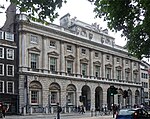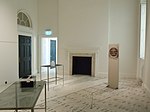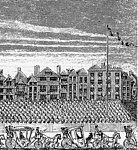Statue of George III, Somerset House

The statue of George III, Somerset House, formally titled George III and the River Thames, is a Grade I listed outdoor bronze sculptural group depicting King George III and Neptune or Father Thames, located in the quadrangle of Somerset House, London, England. The sculptor was John Bacon, and the statue was erected between 1778 and 1789.George III is dressed in Roman apparel, leaning on a rudder, flanked by the prow of a Roman boat and a lion. Father Thames is reclining on a lower, semi-circular plinth, one hand on an urn with a cornucopia behind him.When Queen Charlotte first saw the statue of her husband she asked the sculptor 'Why did you make so frightful a figure?'. Bacon bowed and replied 'Art cannot always effect what is ever within the reach of Nature – the union of beauty and majesty.'
Excerpt from the Wikipedia article Statue of George III, Somerset House (License: CC BY-SA 3.0, Authors, Images).Statue of George III, Somerset House
The Edmond J. Safra Fountain Court, City of Westminster Covent Garden
Geographical coordinates (GPS) Address External links Nearby Places Show on map
Geographical coordinates (GPS)
| Latitude | Longitude |
|---|---|
| N 51.51133 ° | E -0.11742 ° |
Address
George III and the River Thames
The Edmond J. Safra Fountain Court
WC2R 0RN City of Westminster, Covent Garden
England, United Kingdom
Open on Google Maps









